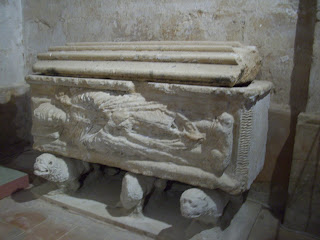
The Monastery of Santa Maria de Huerta, the object of all my 4th of July adventures, is an incredible pile of Cistercian architecture. The monastery was founded in the first half of the twelfth century, and quickly grew to one of the largest houses in Spain.
Strategic donations from the royal family, especially Alfonso VII and Alfonso VIII, along with several noble families of the province of Soria, allowed the Monastery to engage in quite a building program during the later twelfth and early thirteenth century. The original church was expanded into a massive externally Romanesque but internally Gothic structure. A beautiful cloister was added, complete with a refectory large enough to simultaneously feed about 300 monks (it is now down to 20). A major wing was also added for the lay-brothers.
The lay-brothers were an interesting Cistercian institution: these men, not full monks, lived at the monastery and undertook all of the physical labor, especially construction and farming. They did not take part
 in the daily prayers or religious observances of the monks, except for morning mass. Even then, they were physically separated from the monks by the choir screen. Essentially they did all of the Monastery’s heavy-lifting, without getting to fully partake in the religious life which they sought.
in the daily prayers or religious observances of the monks, except for morning mass. Even then, they were physically separated from the monks by the choir screen. Essentially they did all of the Monastery’s heavy-lifting, without getting to fully partake in the religious life which they sought.This Monastery is of particular interest to me because it houses the tomb of Rodrigo Ximénez de Rada, archbishop of Toledo from 1209-1247, and impresario of the battle of Las Navas de Tolosa in 1212. Having read several hundred pages of the man’s extensive historical writings, and having studied the events of his life in detail, a pilgrimage to his tomb seemed fitting. The good Archbishop managed to not be buried in the Cathedral of Toledo, which he founded, because he died in France, while returning from a visit to Rome. He was mummified in Marseilles, and shipped back to Castilla, and dropped off at the first major church willing to take responsibility for him, namely Santa Maria de Huerta. The Canons of the Cathedral of Toledo were mad at their Archbishop over a whole series of nasty but petty disputes, and decided not to pay to have him shipped home. The Cistercians of Santa Maria were happy to have such a famous corpse, and so put him in the corner of their church. There he lay, largely forgotten, until the eighteenth century, when Spanish historians began looking around for this important medieval character. Being buried in an obscure place (which is definitely what Santa Maria became during the 1500s, as the importance of the Cistercian Order faded) worked out well for the preservation of Rodrigo’s tomb: he was undisturbed by the French, who looted many an important grave during the Napoleonic Wars. He was also ignored by the anarchists during the Civil War, who smashed many a clerical grave. He was not, however, ignored by the Church and interested hist
 orians. His grave has been open a total of five times, as successive generations decided to satisfy their morbid curiosity. Finally, after an extensive photo shoot in the 1940s (and the removal of most of his clothing to a museum), the monks reburied him in their main altar, leaving his well-trafficked medieval coffin in its original corner. There he lies, beneath a rather flattering sixteenth century mural of his role in the battle of Las Navas de Tolosa.
orians. His grave has been open a total of five times, as successive generations decided to satisfy their morbid curiosity. Finally, after an extensive photo shoot in the 1940s (and the removal of most of his clothing to a museum), the monks reburied him in their main altar, leaving his well-trafficked medieval coffin in its original corner. There he lies, beneath a rather flattering sixteenth century mural of his role in the battle of Las Navas de Tolosa.Edit: Today, in the Biblioteca Nacional I was reading through a late thirteenth century copy of Rodrigo Ximenez de Rada's historical writings. Inside the back cover, I found this written in a more modern (1500s?) handwriting: "Este Santo Arzobispo esta sepultado en el monasterio de Huerta cerca de Medinaceli, en su sepultura esta este lettero: Mater Navarra, Nutrix Castilla, Schola Pahrisius, Sedes Toletus, Ortus Mausoleum, Requies Caelum". Awesome. I assume that epitaph must have been on the original lid of his coffin (that one isnt the original).
No comments:
Post a Comment